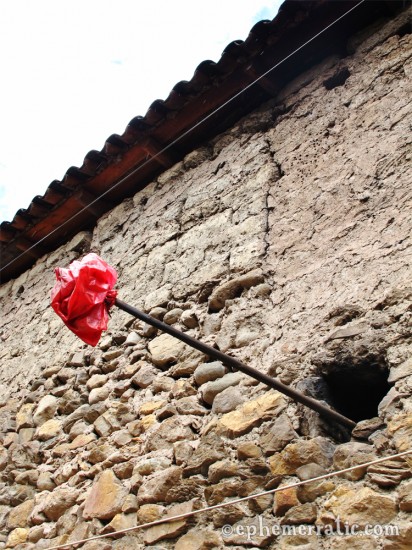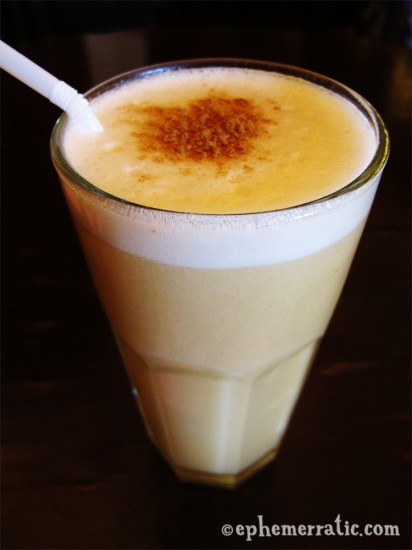Wetting my whistle with someone else’s spit
“Chicha de jora? Isn’t that the stuff they make with spit? Eww.”
Such was the typical reaction when someone heard chicha de jora in the list of foods and drinks I wanted to try in Peru. That or a confused, “Chicha de huh?”
Before I got to Peru, the eww attitude was about where I was at too. While I’m determined to be open minded and try anything, drinking someone else’s spit is a hard notion to swallow.
Spit take
While taking a stroll through the Sunday Market in Pisac, Peru, I squat down to inspect a sack brimming with large kernels of germinated purple-speckled yellow corn, long sprouts intertwined like Los Angeles freeways.
Putting my hand on the pile of kernels for both emphasis and to maintain my balance, I ask, “¿Qué es?”
“Chicha,” she says.
That’s vague. From the little I’ve learned, “chicha” means any Andean beverage in which abundant crops, like corn, are turned into a tasty drink — some boozy, some not. Chicha morada, a near-black unfermented juice of purple corn and spices, was the first beverage I tried after arriving in Peru. I haven’t yet had chicha de jora, the fresh-brewed corn beer drunk by the liter and a key ingredient in authentic Peruvian adobo stews, such as in our recipe for adobo arequipeño.
“¿Chicha de jora?” I ask, putting my hand to mouth and making a cup tipping motion.
She nods.
This is surprising. All I know about making chicha de jora is that you chew some corn, spit it into a bucket with some water, and let it ferment. All mastication, no germination. It’s a production process that sounds like each glass of corn beer should be followed by a Cipro chaser to ward off food poisoning.
Ready. Set. Chew.
It turns out that making chicha de jora is more complicated than letting pre-chewed maize get its booze on.
Basically, a yellow corn, jora, is germinated, dried, and ground up. Then, the pulverized corn is boiled and sweetened, and fermentation begins. It’s brewed in small batches and the results are highly perishable.
In certain circumstances or kitchens, chewing instead of germination might be preferred to break down the corn’s starches into fermentable sugars via spit’s digestive enzymes. Since the result is boiled, a chicha de jora made by chewing wouldn’t have a negative physical effect, just a potential mental one.
Jora, ho!
After two weeks in Peru, a bag of old, spermy-looking corn is the closest I’ve come to finding chicha de jora. My lack of success is mostly due to my lack of focus. I’ve been distracted by all the other new things there are to imbibe, like pisco sours, cerveza Cusqueña, mate de coca, and limonada.
I’m determined though to add chicha de jora to the list of locally-made, fermented drinks that I’ve enjoyed on my travels. Like the seasonal sturm, a lightly fizzy, fermented grape juice briefly available during the first fall harvest in Vienna, Austria. And bahalina, a cloudy white “wine” made from coconut tree sap, which I guzzled on the island of Bohol in The Philippines. And Korean makgeolli, which has made the global commercial leap and is now promoted as “drunken rice” in the U.S.
My lack of success in finding chicha de jora is also due to inexperience. I know that I should be looking for a red plastic bag or ribbons tied to the end of a long pole, which declares “Chicha de Jora Sold Here!” I spotted a few bags from the train to Machu Picchu, sticks stuck in the middle of sweet potato and corn fields. There were a few poles at houses in Ollantaytambo, but I couldn’t find anyone selling it without feeling like I was breaking and entering.
Now in Cusco, I’m suffering from chicha sign blindness, perhaps another symptom of altitude sickness. But I know it’s here, somewhere.
Chichi chicha
My last chance to find chicha de jora before leaving Cusco and the Sacred Valley is at lunch at Gastón Acurio’s gastronomic restaurant with a name that gets my hopes high: Chicha.
There they are, offered on a chalk board in a barely noticeable corner next to the bar, the wonderful words, “chicha de jora.”
It’s a huge glass of creamy, dense, tan liquid, covered with a cloud of foam made by a spin in the blender, a garnish that seems mandatory on every drink in Peru. It smells yeasty and sour, like unbaked bread.
Peru has a reputation for overdoing sweet, and Chicha restaurant’s chicha de jora is unbearably so, tasting mostly of added, refined sugar. I can’t get past the overwhelming, flat-flavored sweetness to appreciate anything else, such as the funky tang that reminds me of fruit that’s a day past edible, but in a good way. There’s nothing appealing about this chicha de jora, and given the surroundings, I suspect it’s not a authentic version.
While my time in the Sacred Valley is over, my search for true chicha de jora is not.
Would you try chicha de jora?





i tried it! i loved it … only after trying it and loving it did i learn about the spit/fermentation process, but it did not affect my thirst. It was the end of the first day of our trek to machu picchu so i was feeling the need for an alcoholic beverage of any sort – to round the day off, like when i have a pint of bitter after a hike back home in England.
It was sweet, but not overly sweet, and it was foamy but not like it’d been in a blender – the bubbles were grey and horrid looking! In fact, if anything it looked like yellowish, cloudy, dirty water someone had sloshed about in a bucket before serving up in a plastic party glass, much to the dismay of most dry-mouthed enthusiasts that wanted to try it after roughly 6 hours of uphill sweat and toil. And I don’t doubt that we were charged double the price for the priviledge, but I enjoyed it all the same …
Did you ever find it in the end?
All long hikes should end with a pint of something, and chicha de jora will do just fine in Peru. I’m glad to hear that you found chicha de jora, even if it was horrid looking.
Spoiler alert: Yes, we find good chicha de jora, in Peru and at home. A story yet to be told!
I love it, my mother knows how to make it (no spit at all) As far as I know the sweetness helps the fermentation and for that “chancaca”, a sort of unrefined sugar is used, that also means that the sweeter chicha is the less fermented. My father classifies it as to refresh, to talk, to discuss and to fight, depending on the level of fermentation, the more fermented is also used to marinade meat, specially goat in the northern Peru, I would say that I love the one that is to discuss, not too sweet, not too sour. Saludos!
“To refresh, to talk, to discuss and to fight” — love it! Pedro, your father is a wise man.
We have a friend in San Francisco that made a batch of less sweet chicha de jora so we could make a pot of Peruvian adobo arequipeño at home.
A little sweet goes a long way with me, but I did finally appreciate a not too sweet, not too sour chicha in Peru.
Chicha de jora, specifically, is not made with the chew-and-spit method. The germination, as you describe, does the saccharification work for you instead. Other types of drinks called chicha are sometimes made that way using non-germinated grains or other sources of starch like cassava.
Chicha seems to be like Oaxacan mole, or Vietnamese pho, or any highly regionalized food — there’s as many ways to make it as there are people that make it. Thanks for sharing another take on the preparation.
Hi :) Searching how to explain chicha de jora in English I found this article of yours. I am not sure where exactly you got this information about the the S P I T thing. I was born in the Peruvian highlands, to be exact 4 hours before Cuzco, a city called Abancay in the department of Apurimac. In Apurimac we also drink a lot chicha de Jora. You can find them in the local markets (these ones have less time of fermentation and they are sweet), the other one you can find them in Chicherias, kind of bar but they just sell chicha de Jora (This one is fermented for a longer time and they don’t have sugar at all). This second one mentioned have red “flags” outside the house as in the picture you showed above.
So for the ones, that plan to go to Peru, don’t be afraid of trying Chicha de Jora in Chicherias :)